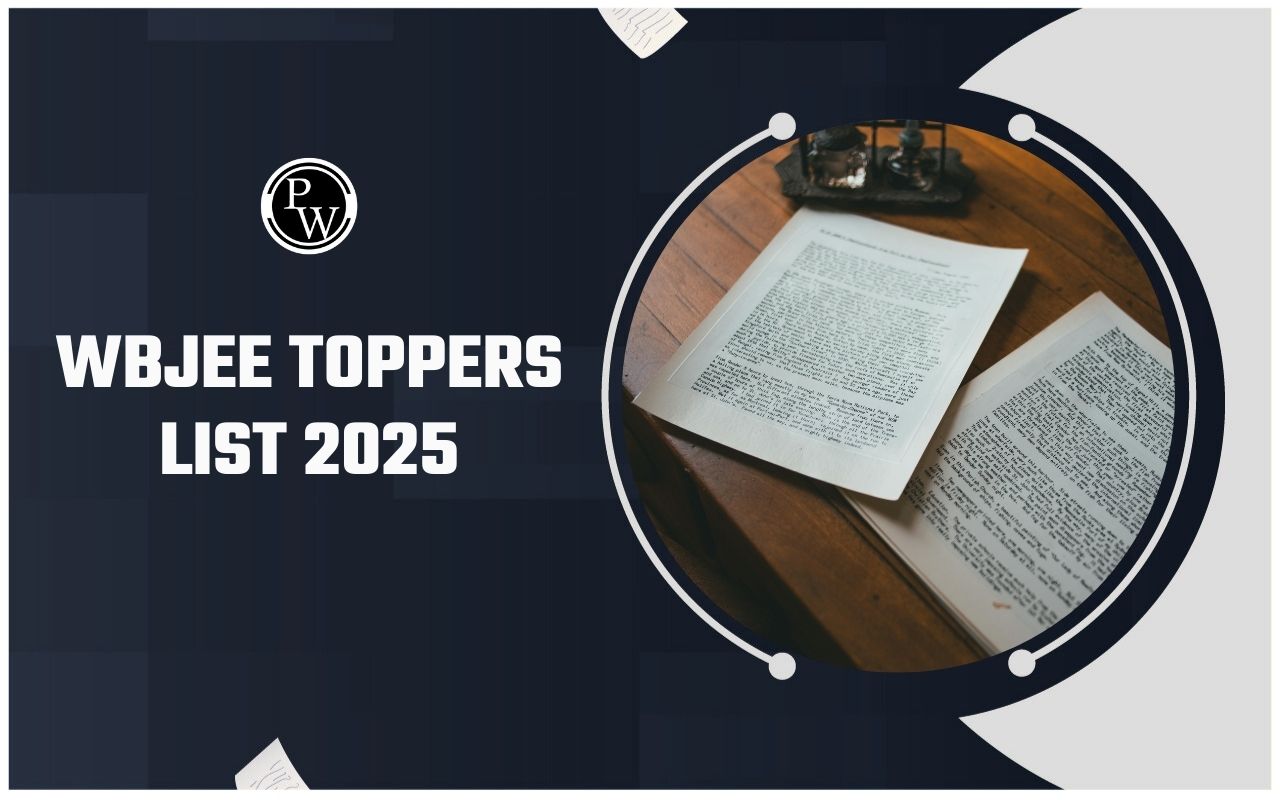
WBJEE Chemistry Syllabus 2025 : Preparing for the WBJEE exam requires a solid grasp of the syllabus, especially in Chemistry. With that in mind, we're providing the WBJEE Chemistry Syllabus 2025 in this article to help you get a head start.
While the official syllabus will be released in December, it’s important to note that it rarely undergoes significant changes from year to year. This syllabus covers all the critical areas of Chemistry, including Physical, Organic, and Inorganic Chemistry, ensuring that you are well-prepared for the exam. By familiarizing yourself with the topics early, you can effectively plan your study strategy and increase your chances of success.WBJEE Chemistry Syllabus 2025 Overview
The WBJEE Chemistry Syllabus 2025 provides a comprehensive guide to all essential chemistry concepts needed for the exam. It ensures students cover all necessary topics, aiding in thorough preparation and a deeper understanding of the subject.| WBJEE Chemistry Syllabus 2025 Overview | |
|---|---|
| Parameters | Description |
| Number of Questions | 40 questions in the Chemistry section |
| Syllabus Division | Breakdown of the syllabus into key sections covering fundamental and advanced topics |
| Topics Covered | Comprehensive list of topics including organic, inorganic, and physical chemistry, along with key concepts |
| Exam Weightage | Distribution of marks, typically including categories with different marking schemes and negative marking policies |
| Mode | Pen and Paper Based (Offline) |
| Total Exam Duration | 4 Hours |
| Total Number of Questions | Chemistry – 40 |
| Medium | English and Bengali |
WBJEE Rank Wise College List 2024
WBJEE Chemistry Syllabus 2025
The WBJEE Chemistry Syllabus 2025 covers all the important areas you need to study for the exam. It includes key topics that help you understand Chemistry better. This syllabus is meant to guide you through your preparation by focusing on both basic and advanced concepts. By following this syllabus, you can make sure you're studying the right topics and improving your chances of doing well in the WBJEE exam.| WBJEE Chemistry Syllabus 2025 | |
|---|---|
| Topics | Sub-topics |
| Atoms, Molecules and Chemical Arithmetic | Dalton’s atomic theory, Avogadro’s Hypothesis, Mole concept, Balanced chemical equations, Concentration units (molarity, molality, normality) |
| Atomic Structure | Rutherford’s model, Bohr’s model, Quantum numbers, Electron configurations, Dual nature of matter |
| Radioactivity and Nuclear Chemistry | Radioactive decay, Half-life, Radioisotopes, Nuclear fission and fusion |
| The Periodic Table and Chemical Families | Modern periodic table, Periodic trends, Properties of elements (atomic radii, ionization energy, electronegativity) |
| Chemical Bonding and Molecular Structure | Octet rule, Covalent bonds, Hybridization, Molecular shapes, Resonance, Hydrogen bonding |
| Coordination Compounds | Werner’s theory, Coordination number, IUPAC nomenclature |
| Solid State | Types of solids, Unit cell, Packing in solids, Band theory of metals |
| Liquid State | Vapour pressure, Viscosity, Surface tension |
| Gaseous State | Boyle’s Law, Charles Law, Ideal gas equation, Dalton’s Law, Real gases |
| Chemical Energetics and Chemical Dynamics | First law of thermodynamics, Enthalpy change, Hess’s Law, Equilibrium constants, Le Chatelier’s Principle, Reaction rates |
| Physical Chemistry of Solutions | Colloidal solutions, Raoult’s Law, Colligative properties |
| Ionic and Redox Equilibria | Ionization of weak electrolytes, pH scale, Buffer solutions, Redox reactions, Nernst equation |
| Hydrogen | Preparation, properties, uses of hydrogen, Hydrides, Heavy water, Hydrogen peroxide |
| Chemistry of Non-Metallic Elements and their Compounds | Allotropes of carbon, Preparation and properties of NH3, HNO3, H2SO4, Halogens |
| Chemistry of Metals | Metallurgy principles, Properties and reactions of typical metals (Na, Ca, Al, Fe, Cu, Zn), Electroplating |
| Chemistry in Industry | Production and uses of H2SO4, NH3, HNO3, Sodium bicarbonate, Polymers |
| Surface Chemistry | Adsorption, Catalysis, Colloidal state, Emulsions |
| Environmental Chemistry | Air, water, soil pollution, Ozone layer, Greenhouse effect, Global warming |
| Chemistry of Carbon Compounds | Hybridization, Isomerism, IUPAC nomenclature, Stability of carbocations and carbanions, Electrophiles and nucleophiles |
| Compounds | Preparation and reactions of alkanes, alkenes, alkynes, haloalkanes, alcohols, ethers, aldehydes, ketones, carboxylic acids, amines, aromatic compounds |
| Application Oriented Chemistry | Ingredients and effects of antiseptics, analgesics, antacids, Vitamin-C |
| Introduction to Biomolecules | Carbohydrates, Amino acids, Peptide bond, ADP and ATP, Nucleic acids |
| Principles of Qualitative Analysis | Detection of acid and basic radicals, Functional groups in organic compounds |
WBJEE Chemistry Syllabus 2025 PDF Free Download
The WBJEE Chemistry Syllabus 2025 PDF Free Download will be available for students to access soon. Having the syllabus in PDF format allows you to review it anytime, anywhere, making your study process more flexible and organized. By downloading the syllabus, you can ensure that you’re fully aware of all the topics you need to cover, helping you to stay on track with your preparation. Keep an eye on the official website for the link to download the PDF as soon as it’s released.WBJEE Chemistry Syllabus 2025 PDF Free Download
WBJEE Chemistry Syllabus 2025 Chapterwise Weightage
The WBJEE Chemistry Syllabus 2025 Chapterwise Weightage provides insight into the importance of each chapter in the exam. Understanding this weightage helps you prioritize your study time, focusing more on chapters that carry higher marks to maximize your score.| WBJEE Chemistry Syllabus 2025 Chapterwise Weightage | |
| Important Topics | Chapter Weightage |
| p- Block Elements | 6% |
| Redox Reactions | 5% |
| Ionic Equilibrium | 4% |
| Chemical Equilibrium | 4% |
| Coordination Compounds | 4% |
| Carboxylic Acids & Derivatives | 4% |
| Alcohol Phenol Ether | 4% |
| Chemical Thermodynamics | 4% |
| Chemical Kinetics | 7% |
| Chemical Bonding | 6% |
| Transition Elements (d & f block) | 6% |
| S block elements | 6% |
| Organic Chemistry | 6% |
Roadmap of WBJEE for Class 10 Students
WBJEE Chemistry Syllabus 2025 Important Topics
The WBJEE Chemistry Syllabus 2025 Important Topics section highlights the key areas you should focus on during your preparation. Concentrating on these topics will help you study more effectively and improve your chances of scoring well in the exam.-
s-block Elements
-
p-block Elements
-
Transition Elements – d&f block
-
General Organic Chemistry
-
Chemical Kinetics
-
Chemical Thermodynamics
-
Chemical Bonding
-
Alcohol Phenol Ether
-
Ionic Equilibrium
-
Redox Reactions
-
Chemical Equilibrium
-
Coordination Compounds
-
Carboxylic Acid & its Derivatives
What is GMR and PMR in WBJEE 2024
The WBJEE Chemistry Syllabus 2025 is an essential tool for students preparing for the exam. By following this syllabus, you can ensure that you cover all important topics thoroughly, leading to a better understanding of the subject and a higher chance of success in the WBJEE exam.| Other Links Related to WBJEE 2025 | |
| WBJEE 2025 | WBJEE Syllabus 2025 |
| WBJEE Apply Online 2024 | WBJEE Eligibility Criteria 2024 |
| WBJEE Previous Year Question Papers | |
1. What topics are covered in the WBJEE Chemistry Syllabus 2025?
2. How many questions are there in the Chemistry section of WBJEE 2025?
3. Is there any negative marking in WBJEE Chemistry 2025?
4. Can the WBJEE Chemistry syllabus change from year to year?
5. What is the weightage of the Chemistry section in WBJEE 2025?










